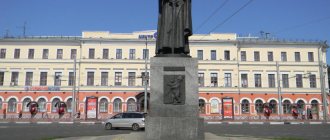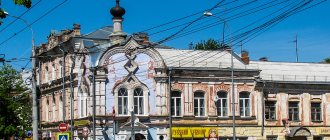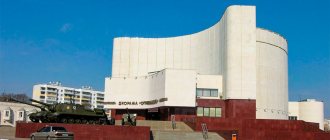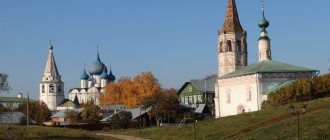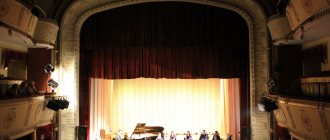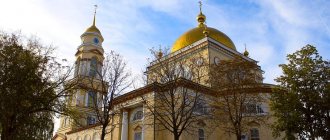Yaroslavl is an old and very beautiful city, one of the most beautiful cities along the well-known Golden Ring of Russia route. IN 2005
year its center acquired the status of a historical heritage. UNESCO included the city in its list of the rarest and most significant architectural monuments, as a heritage of our ancestors.
Most of the buildings were erected in the 17th century
century. Now thanks to them, Yaroslavl is one of the most attractive cities for tourists. Let's look at the most famous sights of the city of Yaroslav the Wise.
Volzhskaya embankment
This is probably the most beautiful embankment of the famous embankments of the river. Volga. IN 1823
last year it underwent reconstruction - the coastline was strengthened, gazebos were installed and new trees were planted. Now only one of the gazebos has survived. On Strelka, where the r. Kotorosl flows into the Volga, you can feel free breathing and wind blowing. The impression of what he saw is breathtaking.
Assumption Cathedral
Began to be built at the beginning of the 13th century
centuries and is considered one of the most ancient temples in the city.
It was repeatedly burned and destroyed by enemies. Under Soviet rule in the 30s
the 20th
century , it was blown up to create a spacious park on the historical site.
The cathedral was restored only in 2020
according to a new project, the event was timed to coincide with the millennium since the founding of the city.
Yaroslavl
History of Yaroslavl
According to written sources, Yaroslavl was founded by Yaroslav the Wise in 1010 on the site of the Meryan settlement Medvezhy Ugol. According to legend, in order to reconquer the land from the pagans, the ruler even had to fight a live bear, as a result of which a club-footed man armed with an ax began to appear on the official coat of arms of the city. The place chosen by the prince turned out to be convenient, first of all, from a strategic point of view: on two sides the new city was protected by the steep banks of the Volga and Kotorosl, and on the third, the steep Medveditsky ravine approached its walls. The Volga trade route, which passed through this territory, was not discounted either.
The Russian 1000 ruble banknote depicts Yaroslavl and a sculpture of the city’s founder, Yaroslav the Wise.
By the 12th century, Yaroslavl had grown significantly, becoming the capital city of the principality: stone churches began to be built there, and the first handwritten books appeared in the library of the Spasskaya Monastery. However, already in the second half of the 15th century, the city completely lost its independence and submitted to Moscow.
Yaroslavl managed to make a real economic breakthrough immediately after the Time of Troubles. By that time, most of the local population had turned to trade, turning their homeland into the country's second largest business site. A golden stream flowed into the city treasury, which gave impetus to the construction of new churches and cathedrals. The city lived in luxury until the ascension to the Russian throne of Peter I, who preferred to look for new trade routes. As a result, business life in Yaroslavl began to slowly but inevitably fade away, and the local merchants had to show remarkable ingenuity in order not to go bankrupt.
Alexey Bogolyubov. “Religious procession on the Volga in Yaroslavl” (1863)
In 1777, Yaroslavl received the status of a provincial city, continuing to bloom and become more beautiful. Educational institutions opened in the city, public parks were established, and even their own periodicals began to appear. The former Bear Corner also managed to satisfy the claims of Dumas the Father himself, who, during his trip to Russia, was indescribably delighted with the convenience of local hotels. People had to pay for external and financial well-being already at the beginning of the twentieth century. During the civil war, the city was subjected to devastating artillery shelling, which destroyed dozens of unique monuments of ancient Russian architecture. Soviet development also made a partial “contribution” to the distortion of the historical appearance of Yaroslavl.
Yaroslavl during the USSR
Economy
Having lost its status as the country's second trading platform at the beginning of the 18th century, Yaroslavl immediately relied on industrial production, thanks to which it found itself in a big plus. The modern city is a self-sufficient industrial center that built its material and economic base back in tsarist times. It is within its boundaries that such production giants as electrical machine-building, motor, car-repair and shipbuilding plants are located. Recently, the oil refinery OJSC Slavneft-Yaroslavnefteorgsintez, located on the outskirts of the city, has been bringing good income to the local budget. The light and food industries are represented by a clothing factory, a brewery, a dairy plant and a factory for the production of felted shoes.
Foreign investment is also being attracted to the city: in the early 2000s, not far from the regional center, a plant of the Japanese company Komatsu grew up, specializing in the assembly of road equipment, and in 2012 a factory for the production of pharmaceuticals of the Swiss concern Nycomed opened in Yaroslavl.
Streets of Yaroslavl
Districts
Geographically and administratively, the city of Yaroslavl is divided into 6 districts:
- Dzerzhinsky;
- Zavolzhsky;
- Kirovsky;
- Krasnoperekopsky;
- Leninist;
- Frunzensky.
Yaroslav the Wise founded Yaroslavl on this site in 1010.
The main flow of tourists falls on the Kirovsky district, which includes the territory of the historical center, where the main architectural attractions are located. Not every Yaroslavl resident can afford to buy an apartment in this part of the city: the area is considered prestigious and real estate prices in it are close to those in Moscow.
The right bank of the Kotorosl was occupied by the city industrial zone - Krasnoperekopsky district or, as the locals say, Perekop. In the 18th century, the distant ancestors of today's enterprises - manufactories - were located here; accordingly, most of the families of factory workers settled in Perekop. Today, tourists visit this area mainly to see the Church of John the Baptist in Tolochkovo, the Church of Peter and Paul and St. Andrew of Crete, the Fedorovsky Church, as well as the Peter and Paul Park.
The largest district of the city is Zavolzhsky, stretching along the left bank of the main water artery of Yaroslavl and known as the place where one of the oldest Orthodox monasteries in Russia is located - the Tolgsky convent. To take an excursion to the temple complex in Korovniki, tourists will have to go to the Frunzensky district, but you can stroll through the exhibition halls of the Museum of Military Glory in the Leninsky district.
Sights of Yaroslavl
It is almost impossible to visit the sights of Yaroslavl in one day. The ideal option is to stay for a couple of days to leisurely and thoroughly explore several dozen of the most outstanding places.
Bogoyavlenskaya Square
You should begin your acquaintance with the capital of the Golden Ring from Epiphany Square or, as the locals call it, Podbelki, where all tourists entering Yaroslavl from Moscow end up. In the center of a small area with circular traffic there is a monument to the founder of the city - Yaroslav the Wise. The main decoration of Podbelka is the Church of the Epiphany. The external appearance of the building is somewhat distorted by unsuccessful restoration (the differences between the shades of bricks of ancient and modern masonry are too striking), but in general you can get an idea of the original appearance of the church.
Spaso-Preobrazhensky Monastery in Yaroslavl
The Spaso-Preobrazhensky Monastery has spread its chapels nearby: today the oldest of the city's stone buildings and the favorite abode of the “tyrant of all Rus'” Ivan the Terrible. Note the rocket-shaped structure opposite his gate. This is the chapel of the Kazan Mother of God, erected in 1997 in memory of the people’s militia gathered by Prince Pozharsky and set off from here on a campaign against Moscow. By the way, it was in the library of the monastery that an invaluable monument of ancient Russian literature was found - “The Tale of Igor’s Campaign”. Hidden behind the monastery is the Church of Elijah the Prophet, which is worth visiting if only to look at the 17th-century altar iconostasis and the picturesque frescoes created by local craftsmen.
Assumption Cathedral on Kotorosl embankment
It is worth noting that there are an incredible number of Orthodox monasteries and churches in Yaroslavl, and new ones are not very common among them. A few exceptions include the Assumption Cathedral on Kotoroslaya embankment. The oldest temple in the city was blown up after the revolution, and what can be seen today in its place is nothing more than a modern copy.
On the territory of the city there are two ancient convents, Kazansky and Svyato-Vvedensky. One of the oldest Russian icons is also located in Yaroslavl, in the Church of the Archangel Michael, so if you come to the city to venerate Orthodox shrines, welcome to the temple on Pervomaiskaya Street. But the Ilinsko-Tikhvinskaya Church on the Volzhskaya Embankment is better known for its pretentious exterior, which is not surprising: services have not been held in the temple for a long time, and its premises are occupied by archives and artists’ workshops.
Kazan Convent
Holy Vvedensky Tolga Convent Church of the Archangel Michael, Yaroslavl
Elias-Tikhvin Church
You can appreciate the frescoes by Russian isographers of the 17th century in the Church of St. Nicholas Nadein, on Narodny Lane, and to pray at the icon “Softening Evil Hearts” you will have to find the Church of the Savior on the City on Pochtovaya Street. Another original architectural monument in the Peter the Great Baroque style is hidden in Peter and Paul Park. The Church of Peter and Paul is not spoiled by visits from curious tourists, since it has not been fully restored, so all those looking for off-the-beaten-path routes should come here. The temple with the 1000-ruble bill is the Church of John the Baptist in Tolochkovskaya Sloboda. The walls of this fifteen-domed structure are lined with colored tiles depicting scenes from the Holy Scriptures.
Church of St. Nicholas NadeinChurch of the Savior on the City
Church of Peter and Paul in Yaroslavl
Church of John the Baptist in Yaroslavl
Spaso-Preobrazhensky Monastery
The Spaso-Preobrazhensky Monastery is located in the very center of the historical part of Yaroslavl, at the confluence…
Church of Elijah the Prophet
The Church of Elijah the Prophet is an elegant snow-white temple located in the center of Yaroslavl, on Sovetskaya…
Museum Music and Time
The Museum of Music and Time is located in Yaroslavl. This is the first private museum in Russia, founded in 1993...
Volzhskaya embankment
The Volzhskaya embankment in Yaroslavl is a bright calling card and the main promenade of the ancient city. Above the bend...
Yaroslavl Zoo
Yaroslavl Zoo is the first and largest landscape-type zoo in the Russian Federation,…
Circus in Yaroslavl
The circus in Yaroslavl is a vibrant entertainment center in the capital of the Golden Ring tourist route...
All sights of Yaroslavl
Interesting places
Going to Yaroslavl just to wander around the historical part of the city is not the right approach to the matter, especially since there are many other exciting routes you can create here. Be sure to walk along Kirov Street, called Yaroslavl Arbat. So far this is the best place in the city for sitting in a cafe and doing a little shopping.
By the way, the residents of Yaroslavl themselves prefer to spend their free time on the embankment, which has three tiers and is considered the most beautiful of all the Volga embankments. You can get here by walking to the end of Pervomaisky Boulevard, another iconic place in Yaroslavl, which locals jokingly dubbed Broadway. Promenades along the main waterway of the city can be combined with a cultural program, since in the vicinity of the Volzhskaya embankment there are several museums (Museum of History, Yaroslavl Art Museum) and historical buildings (Arsenal Tower, Metropolitan Chambers, Tikhomirov estate).
Volzhskaya embankment
Yaroslavl is a rather large city, and if we also take into account its industrial significance, the question of recreational areas immediately arises, which in such places are simply necessary to restore strength and psychological balance. Topping the list of the best vacation spots is the so-called Strelka, a park at the confluence of the Volga and Kotorosl, where there is a monument in honor of the founding of the city. The park itself is two-level: once upon a time, on the site of its upper part there was a chopped city (Kremlin), from which the history of Yaroslavl began. The greatest activity on Strelka reigns in the evenings, since it is at this time of day that the light and music fountains turn on their illumination.
Arrow of Yaroslavl
On weekends, residents of Yaroslavl move to the Damansky Island Park, famous for its mind-blowing attractions and fabulous paths that entangle the entire park area. A favorite place for newlyweds and musical groups is the Governor’s Garden on the Volzhskaya Embankment, where you can not only sit sedately on a bench, but also look into the governor’s house, where a collection of paintings by Russian avant-garde artists is kept.
Damansky Island Park
Governor's Garden on Volzhskaya Embankment
A dolphinarium, a circus and the largest landscaped zoo in Russia are open for little tourists in the city. Well, for those who are not indifferent to the secrets of the Universe, the Yaroslavl Planetarium, built in 2010 and equipped with modern astronomical equipment, awaits.
Circus in Yaroslavl
White lion cubs in the Yaroslavl zoo
Yaroslavl Planetarium
Cultural program
Drama Theater named after
Fedora Volkova If you come with a baby, be sure to go to see “The Golden Key” or “The Canterville Ghost” at the city puppet theater on Svobody Street. For old-school spectators, a chamber theater is suitable. The establishment is in private hands, but, according to reviews, they play here masterfully. A place with centuries-old traditions and an off-scale level of dignity - the Drama Theater named after. Fedora Volkova. Any self-respecting Yaroslavl resident will definitely tell you that this is the first professional theater in Russia, founded by a descendant of a local merchant. You can listen to choral singing, classical musical improvisations and even jazz at the city Philharmonic.
Fans of all kinds of exhibitions will also find something to keep themselves busy, since there are more than a dozen museums in Yaroslavl. You can get acquainted with paintings by Repin, Kramskoy and Perov, unknown to the general public, at the art museum. To hear interesting facts about Yaroslavl and its residents, check out the city museum on the Volzhskaya embankment. In the former merchant's house on Sovetskaya Square there is a museum of foreign art, where the works of the great graphic artists of the Middle Ages are exhibited, including engravings by Albrecht Durer. By the way, most of the exhibits were once owned by private collectors in the city.
T-54 tank and Grad-1 installation in the museum of military equipment
Museum "Aleshino Podvorie"
The male half usually does not miss the museum of military glory, which has a park of military equipment, and young naturalists prefer the museum of entertaining sciences, where you can try on the role of a mad scientist, performing a couple of exciting experiments. To plunge into childhood, you will have to find the house at number 8 on Poshtovaya Street, which is home to at least 700 bears. The exhibition is represented mainly by toys, figurines and other souvenirs, but this does not make it any less interesting.
At the Museum “Music and Time” on the Volzhskaya Embankment they will tell you about the principle of operation of the harmonium, not forgetting to demonstrate the extensive collections of antique watches and porcelain. A unique collection of ancient icons is located in the Museum of Ancient Russian Art in the Metropolitan Chambers. Well, for a real fabulous show you will have to go to the Aleshino Podvorie museum, where the guides are Alyosha Popovich, Lyubava and the prankster brownie.
Yaroslavl in winter
Streets of Kirov in Yaroslavl
Hotels
Travelers who come to Yaroslavl for the “spirit of Russian antiquity” are usually recommended thematic design hotels, for example, “Ioann Vasilyevich” or “Alyosha Popovich Dvor”. Here you will be offered original decorated apartments, a steam bath in a real bathhouse, and traditional Russian dishes. Prices for a standard double room in both hotels are not astronomical: around 2800-3600 rubles.
A large number of housing offers can be found in the vicinity of the historic city center. Basically, these are quite decent establishments with a couple of stars, or without them at all. Some of the mini-hotels in Yaroslavl are located in newly restored historical buildings (Dostoevsky, Kuptsov House), which gives them additional attractiveness in the eyes of tourists.
You can rent a studio or a separate apartment with a good renovation for 2000-2800 rubles. per day. If your budget is bursting at the seams, do not hesitate to look into city hostels such as Oxygen O2, Like Hostel, Attic and Kefir. For five hundred, a homeless wanderer will be provided with a bed in a common room. By the way, in the same “Kefir”, if necessary, they will allocate a warm place for your four-legged friend.
For those who come to Yaroslavl with the aim of fishing, wandering through mushroom places, or simply taking an introductory excursion around the Volga region, there are country hotels and forest cottages - “Bend”, “Coastal Yarburg”, park-hotel “Yaroslavl”. The beauty of such housing is that it is, as a rule, located on the picturesque banks of the Volga and relatively remote from industrial facilities.
Booking.com
Restaurants and cafes in Yaroslavl
Coffee house “Horns and Hooves”
The owners of Yaroslavl cafes are not only enterprising, but also creative people, as the names of the catering outlets themselves clearly hint at. For example, fans of the immortal creations of Ilf and Petrov will definitely appreciate the colorful interiors of the Horns and Hooves coffee shop on Pervomaiskaya. The place is proud of its authentic atmosphere and good quality food (they do not serve fried Keys). For a fatty piece of pork knuckle and a glass of good old schnapps, stop by the U Stirlitz beer restaurant. By the way, on weekdays, from 11:00 to 16:00, there is a tempting 20% discount on the entire menu. If you miss a glass of foam and the gastronomic heritage of the Soviet past - dried vobla, welcome to Afonya. It was not by chance that the owners gave this name to their tiny establishment: it was on the streets of Yaroslavl that the tragicomedy of the same name with L. Kuravlev was once filmed. An economical dining option in the city center for those nostalgic for Soviet interiors is Gastronom No. 1. According to reviews, it is better to come here in the morning: by evening the range of dishes in the cafe becomes noticeably poorer.
Connoisseurs of Asian cuisine should pay attention to the wok cafes "Maneki" and "Tokyo", but in Yaroslavl it is customary to satisfy the longing for hamburgers and fried potatoes in fast food restaurants like McDonald's and KFC.
Holidays and festivals
Once every two years, the streets of Yaroslavl resound with viscous musical rhythms, which signals the beginning of Russia's oldest jazz festival, Jazz over the Volga. In addition, once a year the former Bear Corner gathers professional bell ringers from all over the country, who come here to take part in the Transfiguration music and bell festival.
Every summer, the Yaroslavl Levtsovo airport is stormed by a crowd of thousands of representatives of various subcultures, occupying these places during the Dobrofest rock festival.
Dobrofest
On the last Saturday of May, the whole of Yaroslavl is covered with a wave of unbridled fun: the sky over the Volga is painted with colorful explosions of pyrotechnics, festive excitement reigns in the streets, and musical groups compete in numerous parks. This general riot means only one thing: the festivities in honor of City Day are officially open.
Yaroslavl, City Day
What to bring from Yaroslavl
Souvenir from Yaroslavl
Well, of course, the official symbol of the city is a bear! Porcelain, plush, painted on a T-shirt - in general, in any form, as long as it is clear that this is the Yaroslavl clubfoot.
An ideal gift for the harsh representatives of the stronger half is the products of the local distillery, in particular the well-known balm “Old Yaroslavl”, infused with wild berries and medicinal herbs. If, while walking around the city, you went to the Music and Time Museum, then most likely you came out with porcelain bells in your hands. Speaking of porcelain: the quality of local majolica is considered to be quite high, so don’t hold back and buy a few figurines and cups to commemorate your trip. And here you can also find the legendary “Chaika” watch, yes, the same one from the Soviet past. And don’t forget about Poshekhonsky cheese: after all, the Yaroslavl region is its real homeland.
City's legends
Urban legends of Yaroslavl are not classic tales hastily invented by enterprising guides in order to impose their services on an unlucky tourist.
Here, every horror story has a real basis, sometimes outrageously distorted, but, nevertheless, it took place. For example, if they tell you the legend about Biron’s carriage, which travels along the Volzhskaya embankment at night, then keep in mind that Anna Ioannovna’s favorite, who fell into disgrace, was actually once sent into exile in the former Medvezhiy Ugol. The dancing night lights on Bozhedomka also have their own backstory. In ancient times, there was a cemetery here where suicides, drowned people and vagabonds were buried. They usually did not stand on ceremony with the corpses: they dumped them in a common pit and did not have a funeral service for a long time. The dead, naturally, did not like such inattention, so they started a tradition of wandering around Bozhedomka and giving random passersby a heart attack - at least some kind of entertainment. Among the relatively new horror stories, one can recall the tale of a poltergeist who settled in a pink house with an arch on Red Square. In the 30s, this building was inhabited by the party elite, and then they slowly began to thin out the inhabitants of the house. Unreliable “elements” were quickly identified and disappeared forever, and after a while inexplicable things began to happen in the apartments of the repressed, frightening the new residents. Well, how can we not remember the famous Spassky Monastery, in which, according to some sources, Ivan the Terrible once kept a secret prison. It was not city thieves who were kept in her cells, but personal enemies of the sovereign, with whom only the tyrant himself had the right to talk.
5 things you must do in Yaroslavl
- Dine at the Ioann Vasilievich restaurant and receive a compliment from the chef in the form of “overseas caviar, eggplant.”
- Rub the nose of the bronze bear on Pervomaiskaya Street and listen to the menacing roar that the clubfoot makes once an hour.
- Go to the most beautiful village in Russia according to the results of 2015 - the village of Vyatskoye, which is 25 km from Yaroslavl.
- Take a photo hugging the monument to the heroes of the film “Afonya” at the pub of the same name.
- Support a domestic manufacturer and buy a pair of felt boots, which are made in a local factory. This company has been producing felted boots for over a hundred years, so you can rest assured of the quality of the products you purchase.
Restaurant "Ioann Vasilievich"
Bronze bear on Pervomaiskaya street
Village Vyatskoye
Monument to Athos in Yaroslavl
Transport
Yaroslavl trams
The main types of public urban transport are buses and minibuses connecting all areas of the regional center. Typically, traffic on the streets of Yaroslavl begins at 5:00-6:00 and subsides by 23:00-23:50.
Yaroslavl is one of the few places in Russia now where you can still ride a tram. The line here is old, operating since 1900, and the number of routes is constantly decreasing: for example, in 2009, trams were completely “expelled” from the historical center of the city. However, colorful trailers are still running along the streets of Blucher, Chkalov, Sverdlov and Volgogradskaya. There are also several trolleybus routes in Yaroslavl, which, presumably, will also soon cease to exist.
Useful information: to explore the historical center of the city, wait for trolleybus No. 1, which goes around the main architectural sights.
The cost of travel on any type of public transport is 23 rubles. Either the driver (on a bus) or the conductor (on a tram and trolleybus) must pay for the trip. Electronic travel cards have recently been introduced in Yaroslavl, but buying them is not profitable for a tourist arriving in the capital of the Golden Ring for several days.
There are about fifty taxi companies serving residents and guests of the city in Yaroslavl. As for the costs for this type of transport, the following scheme applies: a fee for calling a car (about 80-100 rubles per landing) plus a fixed fee per kilometer (about 8-11 rubles).
There is also a river station in Yaroslavl, where you can buy a ticket for a motor ship or river bus, which will take you along the Mother Volga with the breeze, giving you the opportunity to admire the romantic panorama of the former Bear Corner.
Yaroslavl River Station
Connection
Cellular communication services in Yaroslavl are provided mainly by the Big Three operators (Beeline, Megafon, MTS), so when going on a weekend to the oldest of the Volga cities, it is not necessary to purchase an additional SIM card. It is enough to activate the necessary roaming option on your existing SIM card in advance or simply change the tariff to a more favorable one, which provides a discount on calls from another region. There are also no difficulties with the mobile Internet: the LTE standard in Yaroslavl was launched quite a long time ago by all cellular operators. Traditional “habits” of free or conditionally free Wi-Fi are local hotels and catering outlets.
How to get there
Yaroslavl has its own Tunoshna airport, which receives flights from Arkhangelsk and St. Petersburg. On average, a flight from the Northern capital takes 1 hour 20 minutes.
Tunoshna Airport
The more popular form of transport is the train. Several routes depart daily from Yaroslavsky Station in Moscow towards the city. In addition, trains going to Arkhangelsk, Syktyvkar and Chita stop in Yaroslavl. The average ticket price is 1100-1600 rubles.
To get to Yaroslavl from St. Petersburg, you will have to start your journey from the Moskovsky station, from where the St. Petersburg - Yaroslavl train and the comfortable Tekstilny Krai train go in the desired direction with a final stop in Ivanovo. From other routes you can choose trains to Ufa and Samara.
You can also get to the oldest of the Volga cities from Moscow by bus (departures from the Shchelkovo bus station every 1.5-2 hours). Travel time will be around 5 hours, ticket price – from 700 rubles.
Those who dare to travel to Yaroslavl by personal vehicle will have to travel along the M-8 Kholmogory highway, through Korolev and Pereslavl-Zalessky. Just 3.5 hours - and you are in Yaroslavl. The road from St. Petersburg through Cherepovets and Poshekhonye will take at least 10 hours.
Church of Elijah the Prophet
Located near the Spaso-Preobrazhensky Monastery. This is a very bright and beautiful church. It was erected in 1647 -1650
gg. merchant brothers Skripin instead of two wooden churches previously built on this site. The majestic building is decorated with five onion domes painted in delicate green colors. There are covered galleries around the church, on the sides there are two tent-bell towers. The temple includes five chapels - the Robe, Pokrovsky, Guria, Aviva and Samona.
Demidov pillar
Located in a picturesque green island of a crowded city - Demidovsky Square. This central part of Yaroslavl has always been a favorite walking place for its residents. Before 1931
year, the square was decorated with a memorial column in honor of the scientist P.G.
Demidova. The Soviet authorities destroyed this
12-
-tall 19th- .
In 2005
, it was restored with funds from the city budget.
Sculptures and monuments in Yaroslavl
Several interesting sculptures and monuments can be seen while walking through the center of Yaroslavl. We'll tell you about the most popular monuments of the city.
Demidov pillar
- Address: Mira Boulevard. Transport stop "Bogoyavlenskaya Square".
Famous naturalist, philanthropist and public figure P.G. Demidov did a lot for the development of education in the province. It is he who is considered the founder of the first university in Yaroslavl - the School of Higher Sciences. In 1829, it was decided to perpetuate the memory of Demidov. Then a monument appeared in the city in the form of a 12-meter column mounted on a granite pedestal. It was crowned with a celestial sphere, above which a gilded double-headed eagle stretched its wings. After the revolution, the monument was demolished, and it was restored in 2005.
Monument to the Bear
- Address: st. Pervomayskaya. Transport stop "Bogoyavlenskaya Square".
As the ancient legend says, Yaroslav the Wise decided to found a city named after him not far from the place where he defeated a bear in a fierce fight. Therefore, a monument to the owner of Russian forests, depicted on the coat of arms of Yaroslavl, simply could not help but be here. The bronze bear, as if climbing a rock, was liked by the residents of Yaroslavl.
Immediately after its opening in 2009, the monument became an iconic landmark of the city. Every hour, from 9:00 to 21:00, a formidable predator emits a terrifying roar, showing who is boss. Having taken a souvenir photo near the monument, make a wish and rub the nose or shaggy side of the bear - then it will definitely come true.
Monument to Athos and plasterer Kolya
- Address: Nakhimson street, 21A.
The monument is installed next to the Afonya beer hall. It was invented and embodied by sculptor Alexey Korshunov. The composition was opened in 2010, on the eve of the 1000th anniversary of Yaroslavl. The initiative to create it belongs to the Yaroslavl Council of Patrons. Ordinary citizens invested in the construction. They voted to create a historical corner on the ancient street.
The fact is that the famous film “Afonya” was filmed in Yaroslavl. The film premiered in 1975. Its main characters instantly became people's favorites. The image of Afoni Borshchov was especially loved by the residents of Yaroslavl. They consider him a congenial person. And they visit his monument with pleasure, taking photographs and selfies against its background.
Cat sculpture
- Address: Deputatskaya, 7.
This composition is located in the historical part of the city. It is an incredibly cute creation. This is a life-size figure of a cat cast in bronze. She seems to be walking along the fence and looking at passers-by. The author of the unusual monument is sculptor Anton Ivashchenko.
The simple and unpretentious plot is fraught with deep meaning. The fact is that in the difficult post-war years, several echelons of furry hunters from Yaroslavl were sent to Leningrad to fight hordes of rodents. Cats saved people, food and art.
Monument "Kopeyka 1612"
- Address: Bogoyavlenskaya Square, 25.
This monument was erected on the initiative of the local Chamber of Commerce and Industry. Opened in 2013. It is a giant copy of a monetary unit that was once minted in Yaroslavl.
The fact is that in 1612 Moscow was captured by the Poles. In this regard, the mint was temporarily located in another city. The tiny silver coin, popularly nicknamed the “scale,” became a real salvation for the Russian resistance. It was with her help that the militias were financed and, in the end, defended their homeland.
The monument is 3 meters high. It repeats the original in the smallest detail. On the front side there is a picture of a horseman with a spear, on the opposite side there is a personal inscription in honor of Tsar Fyodor Ioannovich. The characteristic feature of the Yaroslavl kopek has also been reproduced: the upper part of the side edge is made in the form of a battlement of a fortress wall.
Zero kilometer of the Golden Ring
- Address: Revolutionary street, 13.
Another unique monument. Opened in 2013 in a solemn ceremony. Event date: May 25th. She was not chosen by chance. On this day Yaroslavl turned 1003 years old. The monument is a large cast iron pillar. It was discovered in the estate of the merchant Vakhrameev. Made in the first half of the century before last. The column contains signs with the names of the cities of the Golden Ring with information about the distance to them. At the foot of the memorial sign are the coats of arms of ancient Russian cities, as well as the coat of arms of the Russian Empire.
